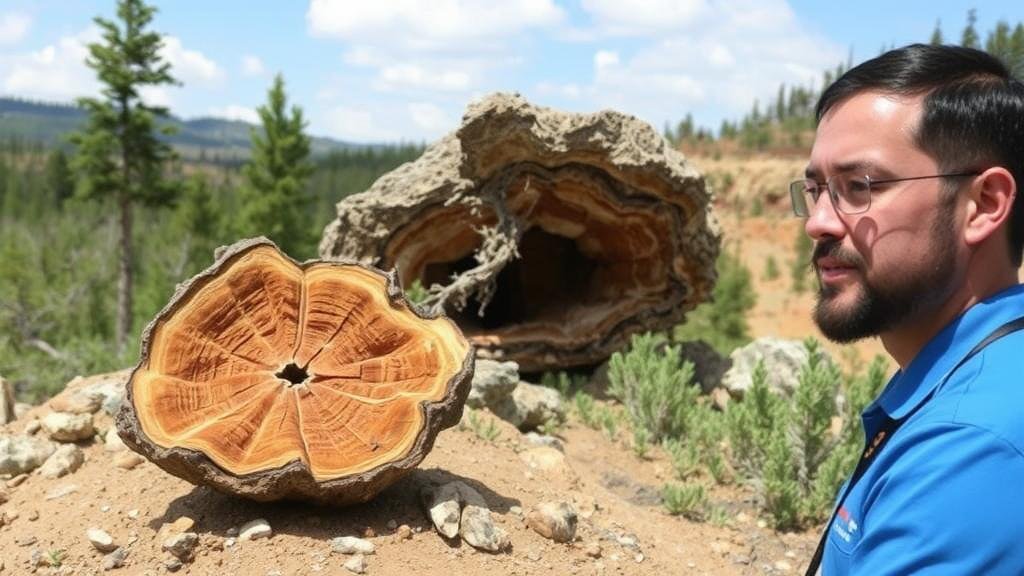Fossilized Forests: Unearthing Petrified Wood in Prehistoric Ecosystems
Fossilized Forests: Unearthing Petrified Wood in Prehistoric Ecosystems
For rockhounds and mineral collectors, the allure of fossilized forests lies not only in their beauty but also in their fascinating geological history. Fossilized wood, or petrified wood, is formed when trees or large woody plants are buried by sediment and subsequently mineralized over millions of years. This article will explore the formation, significance, and collecting of petrified wood, providing insights into prehistoric ecosystems that once thrived on Earth.
The Formation of Petrified Wood
Petrification is a complex process involving decay, mineralization, and preservation. stages of fossilization can be broken down as follows:
- Burial: When a tree falls in a forest, it often gets buried under silt, ash, or sediment, which shields it from decomposing organisms.
- Mineral Infiltration: Groundwater rich in silica and other minerals seeps into the cells of the wood. As the tree continues to be buried and pressure builds, these minerals crystallize, replacing the organic materials.
- Preservation: After millions of years, the original organic structure is completely replaced by minerals, creating a stone-like replica of the wood.
Scientific studies have shown that the process of petrification can take between 20 million and 300 million years, depending on environmental conditions. The resultant fossilized wood often retains the original texture and cellular structure of the tree, making it a treasure for collectors.
Significance of Fossilized Forests
Petrified forests serve as remarkable windows into ancient ecosystems. offer clues about prehistoric climates, types of vegetation, and geological events. Here are a few key points regarding their importance:
- Ecological Insights: Fossilized wood allows scientists to reconstruct past biomes, highlighting how plant life has evolved over millennia.
- Climate Indicators: The study of fossilized trees can reveal historical climate patterns, which are critical for understanding current climate change trends.
- Geological Records: These fossils provide valuable information about Earths geological history, including volcanic activity and tectonic plate shifts.
Locations for Collecting Petrified Wood
Collectors often seek out specific regions known for their rich deposits of petrified wood. Some of the most renowned sites include:
- Petrified Forest National Park, Arizona: This park is famous for its extensive deposits of petrified wood, some dating back to the Late Triassic period, approximately 225 million years ago.
- Giant Forest, California: Located in Sequoia National Park, this area features trees that have been petrified and are among the largest specimens found.
- Oregon’s Painted Hills: These hills exhibit stunning colors and a variety of petrified wood types, drawing collectors from around the world.
Practical Tips for Collectors
For those interested in collecting fossilized wood, here are several practical tips:
- Research Local Laws: Before collecting, ensure you understand the regulations that apply in your region, as some sites are protected.
- Use the Right Tools: Equip yourself with a sturdy rock hammer, small chisels, and safety goggles to ensure a safe collecting experience.
- Start Small: When beginning your collection, consider starting with small specimens rather than large logs. This allows for easier transport and better display options.
- Join a Community: Engaging with local rockhounding clubs can provide insights into the best practices and locations for collecting.
Preserving and Displaying Your Collection
Once you’ve acquired petrified wood, proper care and display are essential:
- Cleaning: Gently clean dusty specimens with a soft brush and mild soap. Avoid harsh chemicals that can damage the surface.
- Display Options: Consider using glass cases or shadow boxes to protect your collection from dust and physical damage while allowing for visibility.
- Climate Control: Maintain a consistent temperature and humidity level to prevent any degradation of the petrified wood.
Conclusion
Petrified wood is more than just a visually striking addition to any collection; it represents a snapshot of Earths history, connecting us to the prehistoric ecosystems that once flourished. By understanding its formation, significance, and proper techniques for collecting and preserving, rockhounds can enjoy a rewarding experience that deepens their appreciation for our planets natural heritage.
In essence, fossilized forests offer a tangible link to ancient life, and by responsibly collecting and studying these treasures, enthusiasts can contribute to ongoing scientific research and conservation efforts.


